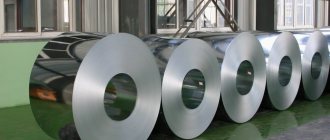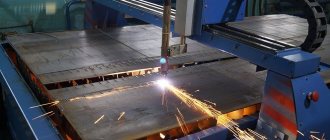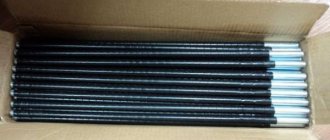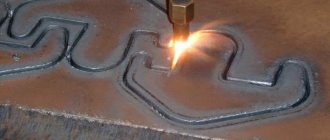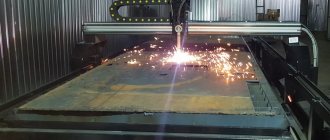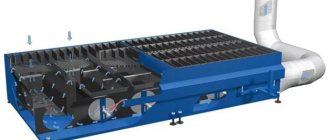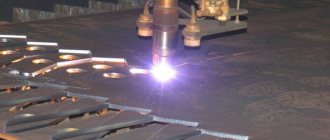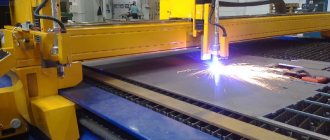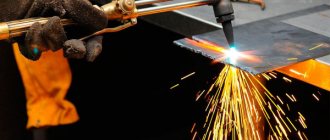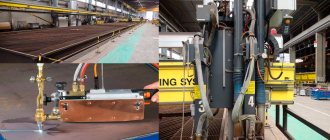A slitting line for rolled metal is a modern approach to the production of strips. Today, various industries could not do without the use of sheet metal. Thanks to technology, such lines meet high standard requirements, and the performance qualities of the metal are preserved during packaging and transportation.
The quality of cutting rolled metal has reached a high level. Especially in industries where cutting machines for cutting rolled steel are used. The output is a product that meets the standard, on which there is no need to carry out additional work.
From the point of view of economic efficiency, it is the transverse and longitudinal cutting of metal that makes it possible to reduce production costs and increase the effect of production.
Prerequisites for large-scale application
The popularity of the rolled metal cutting line is caused by the large assortment of products that the metal slitting line produces. Long-seam pipes and laminated building materials are made from finished products.
Scheme of the main stages of production of longitudinally welded pipes
The cross-cutting line for rolled metal makes it possible to organize the stamping production of various goods; not a single element of casting and rolling complexes can do without it.
When cut, the metal is classified into three types of tin:
- thickness up to 2 mm;
- having a thickness range from 2 to 4 mm;
- thickness over 4 mm.
The first two types of metals require the use of cold rolling, while when cutting 4 mm sheet metal, hot processing is used.
The most widely used in production are rolls produced by cold rolling. This process is performed from metal rolls of the following sizes:
- thickness in the range of 0.25–4 mm;
- width – 12.30 cm,
- length up to 30.00 cm.
Moreover, the weight of such rolls reaches 15 tons.
When cutting such metal rolls, the technical characteristics of this material are taken into account, therefore, in this process, craftsmen use special machines and special equipment.
Roll Metal Cross Cutting Machine
General technical specifications
Technical specifications
- Accuracy of cutting into tape - GOST 19851-74
- Cutting speed - up to 30 (up to 40 - option) m/min
- Dimensions - 15000 x 4700 x 2200 mm
- Power consumption - approx. 40 kW
- Line weight - about 10,500 kg
- Maintenance staff - 2 people
- Heat treatment of disc shear shafts - hardened
Processed material
- Metal thickness - 0.4-0.6 mm (up to 15 cuts), 0.6-1.2 mm (up to 12 cuts)
- Roll weight (max) - 5,000 kg
- Roll width (min/max) — 1250 (+20)
- Tape width - from 50 mm
Peculiarities
Our factory offers several models of such equipment. Differences in the range of thicknesses, and as a result, in design and cost. Therefore, to determine the required configuration, the customer needs to clearly define the technical specifications (raw materials, resulting strip, productivity, quality).
To install the equipment, a flat concrete platform with a pre-prepared technological well up to 7 m deep is required, which allows you to compensate for the different sagging of the cut strip strips and ensure uniform winding of the rolls.
Process technology
At the beginning of the technological process, preliminary cutting of strips to the required length is necessary. Next, electricity is connected to these strips.
The power of the electric current provides spot heating of the strip. This ensures temperature separation and melting of the metal. When determining the current value, the thickness of the strip, the frequency of the supplied electric current and the physicochemical properties of the metal are taken into account.
Longitudinal cutting of metal is necessarily accompanied by local heating of the strip to reduce cutting resistance. This is explained by the fact that heating to high temperatures is accompanied by a decrease in the mechanical properties of the metal. The material slitting line produces more rounded, burr-free strips of smaller width.
This ensures compliance with all standard requirements for the process of manufacturing bent profiles of straight-seam welded pipes.
In addition to this, with this method of cutting strips there is no need for additional processing and other operations. This means that the metal coil slitting line is very cost effective.
Sheet Metal Slitting Line
Slitting line for coiled steel with a thickness of 0.3-0.8 mm. and 500 mm wide.
- Innokenty Kutaisov 3 years ago Views:
1 Shatalov LLC, Russian Federation, Lipetsk region, Gryazinsky district, Kazinka village; TIN, KPP, settlement account Operational office "Nedelina Street" in Lipetsk OJSC "ALFA-BANK", correspondent account, BIC, OGRN t/f.: (4742), web: Slitting line for rolled steel with a thickness of 0. 3-0.8 mm. and 500 mm wide. TECHNICAL CERTIFICATE
2 2 1. INTRODUCTION In connection with systematically carried out work to improve the design of the “Slitting Line for Coil Steel”, there may be some discrepancies between this operational document and the supplied product, which do not affect the conditions of its installation and operation. 2. PURPOSE OF THE PRODUCT 2.1. “Line for slitting steel coils into strips”, hereinafter referred to as “Line” is designed for cutting metal rolls up to 500 mm wide. from various types of steel onto strips of a given width with subsequent winding onto strips. The equipment is installed indoors, climatic operating conditions U4 according to GOST TECHNICAL CHARACTERISTICS 3.1. Initial workpiece material: Cold-rolled thin-sheet products with a base according to GOST; GOST Electrical steel according to GOST and according to GOST width, mm to thickness, mm 0.25-0.8 Internal diameter of rolls, mm Max roll weight, t. 5, Cutting speed, m/min Power consumption, kW kW 3.5. Number of service personnel, people Maximum number of cuts with metal thickness 0.25mm/35pcs; 0.3mm/30pcs; 0.5mm/25pcs; 3.7. The technical requirements for the strip cut on the slitting line may comply with the following GOSTs: ; and COMPLETENESS 1) Cantilever unwinder, diameter internal mm., drive power 3.0 kW, equipped with a frequency converter, mode of bringing the petals together and spreading them manually, capacity 5.0 tons; 2) Disc shears with an inlet filling unit, a set of disc knives according to customer technical requirements, a set of spacer bushings
3 3 according to the cutting map and cut ratio; corresponds to the number of knives; set of rubberized rings 3) Pit looper (used to compensate for the length of cut metal strips). 4) Tension device (electromechanical press) with dividing rollers, electromechanical drive 4 kW; 5) Console type winder, F int. 200 (500) mm., electromechanical drive 10.5 kW, equipped with a frequency converter, mode of bringing the petals together and spreading them manually, lifting capacity 5.0 tons; 7) The mechanism for removing cut tape in rolls is a supplied console equipped with a mechanical winch; Control system for slitting line units. 7. INSTALLATION PROCEDURE, ADJUSTMENT AND ADJUSTMENT 7.1. Installation and alignment of the line in the longitudinal and transverse directions is carried out according to the level. Installation accuracy 0.5 mm over a length of 1000 mm After aligning the line, fill the foundation bolts (if any) with concrete, tighten the nuts after it has hardened. It is possible to install the line on a common frame made of rolled metal. After installation, check the operation of all components of the line manually. 8. SAFETY 8.1. Comply with all general safety rules when working at machine-building enterprises and the safety requirements specified in GOST R. The slitting unit is an object of increased danger. A moving strip with sharp edges, operating mechanisms, electrical machines, moving electric bridge cranes with loads, and floor transport require technical personnel to perform safety precautions. If it is difficult to remove windings from the winder drum, it is prohibited to continue cutting until the causes of the problem are eliminated. Persons at least 18 years of age who have been practically and theoretically trained in the relevant profession (cutter, senior cutter, operator) are allowed to work on slitting units. General requirements for technical safety are: - come to work prepared;
4 — follow the rules of wearing protective clothing; — while working, be attentive and not be distracted by extraneous matters; - walk only along established pedestrian routes and footbridges; — after completion of repair work on the unit, rags, spills of oil and kerosene must be removed, the area must be cleaned; - do not allow repair work to be carried out using open fire without a permit; — do not allow unauthorized persons into management posts and workplaces; — comply with the rules of the tag system; — safety requirements are set out in labor protection instructions for all professions. It is strictly prohibited to work on the line with one person. There must be at least two people on site. Adjustment and adjustment of a running unit is not allowed. After installing the line at the site of operation, ground the frame, electric motor and control cabinet by connecting to the general workshop grounding loop. 10. CONDITIONS OF OPERATING EQUIPMENT At the workplace of the Line there must be: - a passport for the Line; — safety regulations; — technological (production) instructions; — maintenance log, operating log; All work related to maintenance is carried out by specialists with the equipment disconnected from the network. The following types of maintenance are provided: — TO-1 is performed daily. Before starting work, check and ensure that all components are in working order. Clean the mechanisms from dirt and dust. Test turn on the electric motor for 1-2 minutes. — TO-2 is performed once a month. Check the bearings of motors and gearboxes for heating. Check the presence of lubrication and oil level in the gearboxes. If necessary, add oil. Inspect fasteners, rollers, and tighten if necessary. — TO-3 is performed once every three months. Adjust the working parts. Check the drive fastening, rotation and serviceability of the shafts. Check the oil level in the gearboxes. If the oil level decreases due to a leak, add oil only after eliminating the reasons causing the leak. Take measurements of the electrical resistance of grounding devices. It should be no more than 4 ohms. Take measurements of the insulation resistance of devices and 4
5 electrical wires with appropriate documentation. The resistance values must correspond to the current PTE and PTB. — TO-4 is performed once a year. Inspect bearing units. Replace the grease in the bearings. Change the oil in the gearboxes. Check the accuracy parameters. Work on the line is allowed to persons trained to work on this equipment, who have received detailed safety instructions, and who have permission to work with load-handling and lifting mechanisms. A log of operating hours on the Line and a maintenance log are filled out every day. Use high-quality raw materials in the production process. Temperature conditions operation: +5C - +35C 5 Manufacturer Slitting lines Shatalov LLC, Lipetsk, st. Furmanova, 47 telephone (4742);
Features of the work process
The transverse metal cutting line, together with the longitudinal cutting line, has a similar operating principle. The material is held by special disc shears, and then, after fixation, cutting occurs between the upper and lower shafts.
The separation occurs under the influence of tension pressing against the upper shaft. During the entire process, the upper and lower rollers are constantly kept in motion for continuous feeding of sheets.
Since heat weakens the rigidity of the metal, the cutting process often replaces the disks with carbon steel rollers, pre-heating the metal electrically. When replacing discs with rollers, craftsmen ensure high cutting quality.
Profitability
The efficiency of such an enterprise in the modern market is high, but the main factors can significantly affect the annual profit. If production is located in a remote city, sales and packaging of finished products occurs irregularly. In this case, demand falls, as well as the main percentage of cash injections.
It is necessary to locate an enterprise of this type within the boundaries of an industrial region where the demand for manufactured products will be high.
Video: Rolled metal slitting line
Source: promzn.ru
Types of cutting and why they are needed
Narrow metal strips are in demand in both mass and small-scale production.
In the first case, the manufactured products are intended for use in ventilation systems and roofing work, and for the installation of advertising structures.
Ventilation system parts
And in small-scale production, which in practice means more delicate work, jewelry-quality metal is cut.
In this type of production, the following classification of cutting types is distinguished:
- figure cutting is a process when a figure is designated in advance, along which the laser moves and cuts out an element specified by the program. When cutting decorative items, this method avoids damage;
- cutting metal along a contour is a process after which the material is not subjected to further polishing or any processing. When cutting complex shapes, this cutting method is indispensable. The diameter of the cutting beam does not exceed 0.4 mm;
- Laser cutting is a more modernized technology that can significantly reduce the processing process without affecting quality. Moreover, this technology is very inexpensive, because there is no cutting and milling process.
The exact shape of the final product is ensured by technology that eliminates dynamic effects on the product. Laser cutting is used in the manufacture of furniture sets, various equipment, and machines.
After laser cutting, the surface of the material becomes perfectly smooth and polished. The laser depth can also be adjusted, which is very important when cutting complex shapes.
Cross cutting of metal is a complex process that requires true professionalism and scrupulous adherence to the rules from the craftsmen.
At each stage, the technology has checkpoints, this helps to check the correctness of the work, as well as the condition of the product.
Therefore, the use of a metal longitudinal-transverse cutting line helps speed up the process of manufacturing parts and products. The cutting line consists of several combined parts, this allows the technology to be divided into small logical cycles. Due to this, the cutting process is significantly accelerated.
Cutting of coil reinforcement
The fittings produced by our enterprises are supplied to metalworking shops in the form of coils. This is done for the convenience of transporting products. In order to obtain bars of the desired size, cutting of coil reinforcement is provided.
Organizations involved in drawing and cutting coiled reinforcing material are equipped with high-tech equipment in the form of straightening and cutting machines. Therefore, the cutting process is always preceded by the unwinding of coils with reinforcing wire. The automation allows for working with materials of various diameters; the length of the rod fittings corresponds to customer requirements.
First, the coils with reinforcement are installed on reels that are at least 2 m away from the machine drums. The height of the lifting of the coils is about 40 cm. After the wire is passed through the correct drums, it goes to a movable stop, where the required length of the rods is measured. The stop, which is controlled by cables, is connected to knives; they cut the reinforcement in the required place.
Cutting of coil reinforcement is especially in demand today in the construction industry. The production of concrete products requires the presence of reinforcement of different diameters and lengths.
Longitudinal-transverse cutting
offers services for cutting and processing metal, manufacturing metal structures and products of any complexity. Transverse cutting of sheets and rolls with a thickness of 0.4 to 3.0 mm, width up to 1500 mm, length up to 5000 mm, accuracy +/- 0.5 mm. Longitudinal cutting of rolls with thickness from 0.3 to 2.0 mm, width up to 1500 mm, weight up to 15 tons. Minimum strip width 19mm, accuracy +/-0.1mm. All products undergoing processing are of high quality, which is achieved by powerful and productive equipment of the Gabella brand (Italy).
Cost of longitudinal-transverse cutting of rolled products
We offer services for longitudinal and transverse cutting and processing of rolled metal, manufacturing of metal structures and other products of any complexity. Longitudinal cutting of coiled steel is carried out with material thickness from 0.3 to 2.0 mm, coil width up to 1500 mm - weight up to 15 tons. The high tolerances and excellent characteristics of the knives used on the line eliminate burrs and other edge imperfections. The longitudinal incision is performed using powerful equipment from the Italian brand Gabella.
If finished products are available, delivery is carried out on the day of order (Moscow and the region). Prices are calculated individually. To find out about the cost of products and learn about additional services, contact our managers.
Source: ros-stal.ru
Cutting long products
This type of activity, such as cutting rolled metal, is included in the list of basic services of every metal service. There are two methods of cutting metal: longitudinal and transverse. A subtype of the longitudinal method is cutting long products. Long rolled metal products are distinguished by a large amount of processed material, which introduces some features into the method of cutting metal raw materials. Here it is also necessary to distinguish between cutting long sheets and reinforcing bars. Both varieties require a special approach.
Cutting of long-length (sheet) products is carried out on special equipment, consisting of a reel on which a coil of metal sheet is strung, a feeding device, powerful scissors and a receiving mechanism. The machines differ in the cutting method; there are devices for longitudinal and transverse processing of long steel. The equipment differs from each other in some technical characteristics, and can cut steel of different thicknesses and structures.
Cutting long (rebar) bars involves the use of a slightly different type of equipment. Before the cutting process, the coil is unwinded, then the reinforcement is straightened and only after that it goes to powerful hydraulic shears, where a part of the wire of a given length is separated.
Source: www.rusmetprom.ru
